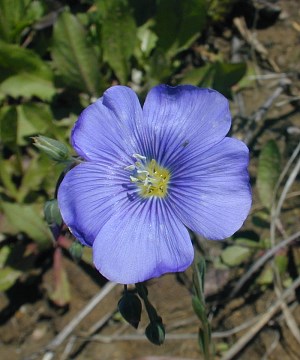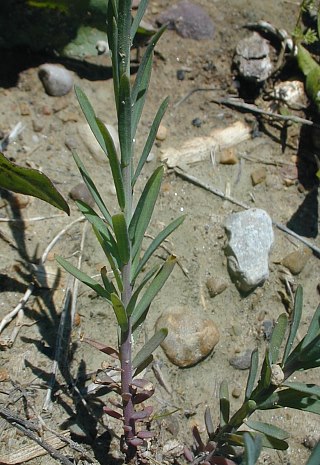Description:
This
perennial wildflower is 1–2½' tall, sending up one or more
unbranched stems from the base. Depending on environmental conditions,
these flowering stems are more or less erect, or they can sprawl across
the ground. The stems are gray-green or gray-blue, terete, and
hairless. Arranged around each stem, there are dense pseudo-whorls of
small leaves. These leaves are are up to 1½" long and less than ¼"
across; they are linear-oblong, gray-green or gray-blue, smooth along their margins,
and hairless. Each stem
terminates in a cyme of about 10 flowers. While the flowers are in the
bud stage, the slender branches of the cyme usually droop downward.
When a flower blooms, it becomes more erect. Individual flowers are
about ¾–1" across, consisting of 5 light to medium blue petals, 5 dull
green sepals, 5 stamens with white anthers, and 5 slender styles. The
petals are much larger than the sepals; they have dark blue veins that
radiate from the center of the flower. Individual sepals are ovate with
membranous hairless margins. The blooming period usually occurs during
early to mid-summer. The short-lived flowers up open during the early
morning and close by noon. After the blooming period, each flower is
replaced by a globoid seed capsule. Each capsule contains 10 cells (5
fertile cells and 5 sterile cells) and 10 flattened seeds. The root
system consists of a deep taproot. This wildflower reproduces by
reseeding itself.
their margins,
and hairless. Each stem
terminates in a cyme of about 10 flowers. While the flowers are in the
bud stage, the slender branches of the cyme usually droop downward.
When a flower blooms, it becomes more erect. Individual flowers are
about ¾–1" across, consisting of 5 light to medium blue petals, 5 dull
green sepals, 5 stamens with white anthers, and 5 slender styles. The
petals are much larger than the sepals; they have dark blue veins that
radiate from the center of the flower. Individual sepals are ovate with
membranous hairless margins. The blooming period usually occurs during
early to mid-summer. The short-lived flowers up open during the early
morning and close by noon. After the blooming period, each flower is
replaced by a globoid seed capsule. Each capsule contains 10 cells (5
fertile cells and 5 sterile cells) and 10 flattened seeds. The root
system consists of a deep taproot. This wildflower reproduces by
reseeding itself.
Cultivation:
Full sun, dry conditions, and barren soil containing sand, clay, or
rocky material provide the best environment for growth and development.
Under more moist and fertile conditions, this wildflower may sprawl or
succumb to competition from other plants. The pH of the soil should
range from mildly acid to alkaline.
Range & Habitat:
The non-native Wild Blue Flax rarely naturalizes in Illinois (see Distribution
Map). Habitats include roadside embankments, gravelly areas
along railroads, and vacant lots where old homesites once existed. This
wildflower could probably adapt to dry gravel, hill, and sand prairies,
if it was introduced (not that I'm recommending it). Occasionally, this
species is cultivated in flower gardens, from where it can escape. Wild
Blue Flax is native to the Great Plains and western areas of the United
States.
Faunal Relationships:
Because this wildflower is introduced, information about its
floral-faunal relationships in the Midwest are limited. The flowers are
pollinated primarily by small bees and Muscoid flies (Kearns &
Inouye, 1994). The bees usually suck nectar, while the flies usually
feed on pollen. In the western states, upland gamebirds (e.g., Sage
Grouse) and deer mice eat the seeds; it is possible that the Greater
Prairie Chicken and Ring-necked Pheasant would eat the seeds in
Illinois. While the foliage contains a cyanide-related compound, it is
browsed occasionally by hoofed mammalian herbivores (both wild and
domestic), including White-tailed Deer and Elk. Apparently, these
animals can eat small amounts of the foliage without experiencing
significant toxic effects.

Photographic
Location:
A roadside embankment that was adjacent to a flower garden, where this
plant was cultivated near Champaign, Illinois.
Comments:
Wild Blue Flax has very pretty flowers, although they are rather
short-lived. While its stems appear to be slender and fragile, they are
actually rather fibrous and tough; their fibers were used for various
purposes by Amerindians. In this genus, Linum spp. that
are native to Illinois have yellow flowers. Like Wild Blue Flax, they
usually prefer sunny dry habitats with barren soil. Another introduced
flax with blue flowers, Linum usitatissimum
(Cultivated Flax), is an annual that is native to Eurasia or the Middle
East. This latter species has been cultivated for its fibers for
thousands of years; it is the source of linen cloth. Unlike Wild Blue
Flax, the sepals of Cultivated Flax have acutely pointed tips; the
inner sepals also have ciliate margins.